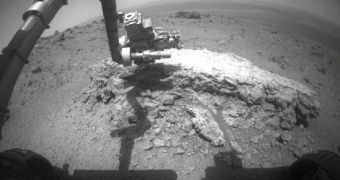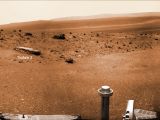Having arrived at Endeavour Crater a few weeks ago, the Mars Exploration Rover (MER) Opportunity has already begun analyzing outcroppings and rocks at the edge of the massive landscape feature. Its attention is currently focused on a piece of rock called Tisdale 2.
Endeavour is about 14 miles ( 22 kilometers) wide and very deep, which means that it exposes a large number of rock layers. For a machine developed with geological research in mind, studying the entire complex is a walk in the park, provided that the robot has sufficient time.
It landed about 33 kilometers away from the large crater's rim about 7.5 years ago, and it has been conducting scientific research ever since. Together with the other MER component, Spirit, the rover has produced valuable insights into the nature of Mars and its geology and hydrology.
Spirit is now officially dead, after trekking the surface of the Red Planet for nearly 7 years in its own right. Though it traveled shorter distances than Opportunity, it garnered more attention due to the fact that it encountered a lot more adversities than its counterpart.
Since only one exploration robot remains, mission controllers at the NASA Jet Propulsion Laboratory (JPL), in Pasadena, California, want to make the best of it, producing as much science as possible. JPL scientists refer to Endeavour as Opportunity's new landing site.
“This is like having a brand new landing site for our veteran rover. It is a remarkable bonus that comes from being able to rove on Mars with well-built hardware that lasts,” NASA Headquarters MER program executive Dave Lavery explains.
Opportunity's current target – Tisdale 2 – is located on a low ridge called Cape York. It represents the first rock that the rover began to investigate since arriving at the crater. The robot has been driving to get at its current location for the past 3 years.
“This is not like anything we’ve ever seen before. So this is a new kind of rock. It has a composition similar to some volcanic rocks, but there’s much more zinc and bromine than we’ve typically seen,” MER principal investigator Steve Squyres explains.
“We are getting confirmation that reaching Endeavour really has given us the equivalent of a second landing site for Opportunity,” adds the expert, who is based at the Cornell University in Ithaca, N.Y.
“The other big take-away message, and this is to me the most interesting thing about Tisdale, is that this rock has a huge amount of zinc in it, way more zinc than we have ever seen in any Martian rock. And we are puzzling, we are thinking very hard over what that means,” he adds, quoted by Universe Today.

 14 DAY TRIAL //
14 DAY TRIAL // 
